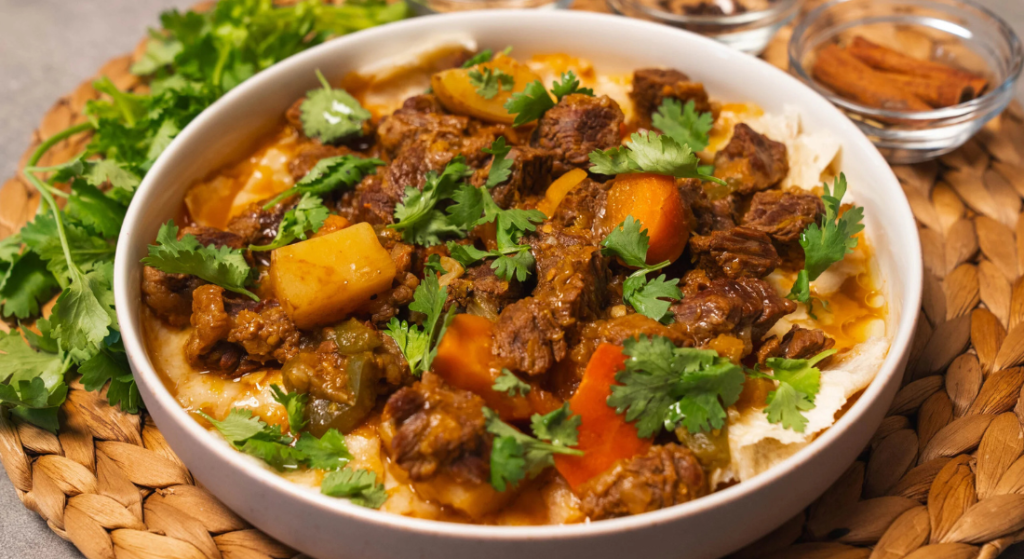
A champion of Emirati flavours, Chef Maitha Warshaw is a pioneering cook renowned for her innovative approach to traditional cuisine. A graduate of the Culinary Arts Academy Switzerland, she has seamlessly blended her rich cultural heritage with contemporary culinary techniques. She founded Presto, a local pop-up celebrated for its artisanal soft-serve ice cream and unique slushy flavours. Her participation in international events, such as creating meals for guests attending the most recent Olympic Games, has seen her reputation go global.
From the deep-rooted memories of my childhood in the UAE, where food was always at the heart of every gathering. I grew up surrounded by the aromas of comforting flavours of Emirati dishes prepared by my father and grandmother. Their passion for cooking wasn’t just about food – it was about storytelling, heritage, and bringing people together. Over time, this love evolved into a creative pursuit, taking traditional flavours and reimagining them in new, exciting ways.
Growing up, I was always drawn to the way food could bring people together and evoke powerful memories. My father and grandmother played a huge role in shaping my passion, teaching me the importance of flavours, patience, and tradition. While my love for cooking started at home, I initially pursued other career paths. But the call of the kitchen was too strong to ignore. I started experimenting with modern takes on traditional Emirati flavours, blending nostalgia with creativity. Over time, I refined my craft through hands-on experience, working with local ingredients and techniques to develop dishes that felt both familiar and innovative.

For large gatherings, I love preparing lamb harees. It’s one of the most comforting and traditional dishes, slow-cooked until the wheat and tender lamb merge into a rich, hearty porridge-like consistency. For suhoor, I enjoy serving regag bread with toppings like cheese, honey, or eggs. It’s simple, quick to make, and keeps you feeling full throughout the fasting hours. Plus, it’s a great way to bring people together, everyone loves tearing off a piece and enjoying it fresh off the pan!
One of my fondest memories of Ramadan in our family kitchen was the sound of my grandmother stirring a jug of laban (buttermilk) just before Maghrib. The aroma of spices and slow-cooked meals would fill the house, and I remember eagerly watching my father as he prepared our iftar spread.
There are a few dishes that have been part of our Ramadan table for generations. One of the most cherished is thareed, a dish where crispy regag bread is soaked in a rich, slow-cooked meat or vegetable stew. It’s a Ramadan staple in many Emirati households. I love how it brings warmth and comfort after a long day of fasting.
Another special recipe is luqaimat – golden, crispy dumplings drizzled with date syrup and sesame seeds. My grandmother’s recipe has been passed down through the family, and every Ramadan, we make it together, just as she did with my father when he was young.

Homemade Lamb or Chicken Broth (Marag)
1 kg bone-in lamb (shank, shoulder, or ribs) or chicken
8 cups water
1 large onion, quartered
3 cloves garlic, crushed
1 tbsp ghee
1 dried black lime (loomi), pierced
1 cinnamon stick
2 bay leaves
1 tbsp whole coriander seeds
1 tsp whole black peppercorns
1/2 tsp turmeric powder
1 tbsp salt
Thareed Stew (Main Dish)
2 tbsp ghee
1 large onion, finely chopped
3 cloves garlic, minced
2 tomatoes, finely chopped
1 tbsp tomato paste
1 large carrot, chopped
2 medium potatoes, chopped
1 zucchini, chopped
1 small eggplant, chopped (optional)
1/2 cup chickpeas, cooked (optional)
4 cups homemade broth
(see before)
Spices & Seasoning
1 tbsp ground coriander
1 tbsp ground cumin
1 tbsp ground turmeric
1 tsp ground cinnamon
1 tsp ground black pepper
1 tsp paprika
1 dried black lime (loomi), pierced
2 bay leaves
1 tsp salt (adjust to taste)
Traditional Regag Bread
1 cup whole wheat flour or
all-purpose flour
1/2 cup water
1/4 tsp salt
1/2 tsp sugar
1 tsp ghee or vegetable oil
Prepare the Homemade Broth (Marag)
1. In a large pot, melt ghee and add onions and garlic. Sauté until golden.
2. Add lamb or chicken and sear for
5 minutes.
3. Pour in 8 cups of water, bring to a boil, and skim off any foam.
4. Add dried black lime, cinnamon, bay leaves, coriander seeds, black peppercorns, turmeric, and salt.
5. Simmer for 1.5 to 2 hours (for lamb) or 45 minutes (for chicken) until tender.
6. Strain the broth and set aside the cooked meat and broth.
Make the Thareed Stew
1. Heat ghee in a pot, sauté onions and garlic until fragrant.
2. Stir in tomatoes, tomato paste, and all the spices (coriander, cumin, turmeric, cinnamon, paprika). Cook for 5 minutes.
3. Add the cooked lamb or chicken, mix well.
4. Pour in 4 cups of the homemade broth and bring to a simmer.
5. Add carrots, potatoes, zucchini, eggplant, and chickpeas. Simmer for 30 to 40 minutes.
Prepare the Traditional Regag Bread
1. In a bowl, mix together flour, salt, sugar, and water to make a thin, smooth batter.
2. Heat a flat pan over medium-high heat. Lightly grease with ghee.
3. Pour a thin layer of batter onto the pan and quickly spread it using the back of a spoon.
4. Cook for 1-2 minutes until crispy. Flip and cook for another 30 seconds.
5. Remove from heat and repeat for 3-4 pieces.
Assemble the Thareed
1. Place the crispy regag bread in a large serving dish.
2. Pour the hot stew and broth over the bread, allowing it to soak slightly.
3. Arrange the meat and vegetables on top.
4. Garnish with fresh coriander (optional) and serve.